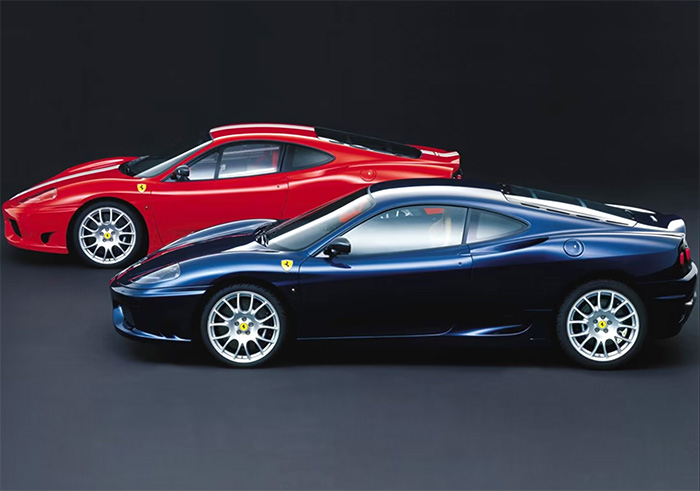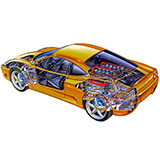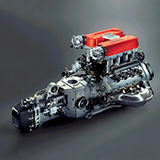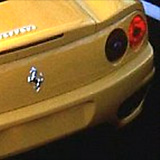FErrari 360 challenge stradale
DETAILS AND SPECIFICATION OF THE CAR
Inspired by the 360 Modena Challenge racing car series, the Challenge Stradale is the track-focused iteration of the 360 Modena which followed on in concept from the track focused F355 "Fiorano", which featured the "Fiorano Handling Pack" introduced in the final year of the Ferrari F355. The focus in development of the car was primarily on improving its track performance credentials by concentrating on handling, braking and weight reduction characteristics, which are essential in pure racing cars. Ferrari engineers designed the car from the outset with a goal of 20% track day use in mind and 80% road use. With only a small 25 PS (18 kW; 25 hp) improvement in engine power from the Modena (and boasting an improved power-to-weight ratio), the Challenge Stradale accelerates from 0 to 100 km/h (62 mph) in 4.1 seconds according to Ferrari. Systematic improvements were achieved to the setup and feel of the whole car; throttle response from the digital throttle was ratcheted up and feedback through the steering wheel was enhanced. Ceramic brakes borrowed from the Enzo, some lower weight parts and a FHP handling pack, enabled the Challenge Stradale to claim a 3.5 second improvement per lap of its Fiorano Circuit compared to the Modena.
In total, the Challenge Stradale is up to 110 kg (240 lb) lighter than the standard Modena if all the lightweight options are specified such as deleted radio, lexan (plexiglass) door windows and Alcantara fabric (instead of the leather option). As much as 74 kg (163 lb) was saved by lightening the bumpers, stripping the interior of its sound deadening and carbon mirrors and making the optional Modena carbon seats standard. Resin Transfer Moulding was utilised for the bumpers and skirts, a carry over from the Challenge cars which resulted in lighter bumpers than those on the Modena. The engine and transmission weight was lightened by 11 kg (24 lb) through the use of a smaller, lighter weight sports exhaust back box and valved exit pipes. The Challenge Stradale also got Brembo carbon ceramic brakes as standard (which later became standard fitment on the F430) which shaved 16 kg (35 lb) off the curb weight and improved handling by reducing unsprung weight and completely eliminating brake fade, as well as lightweight wheels specially made by BBS. Cars fitted with the centre console stereo option, sub speaker box behind the seats and glass side windows re-gained approximately 30 kg (66 lb) over the best selected options.
Dimensions
- Overall length: 4,477 mm (176.3 in)
- Overall width: 1,922 mm (75.7 in)
- Height: 1,199 mm (47.2 in)
- Wheelbase: 2,600 mm (102.4 in)
- Front track: 1,669 mm (65.7 in)
- Rear track: 1,617 mm (63.7 in)
- Dry weight: 1,180 kg (2,601 lb)
- Curb weight: 1,430 kg (3,153 lb)
- Fuel capacity: 95 L (25 US gal; 21 imp gal)
Engine
- Type: Naturally aspirated 90° V8 engine F131
- Position: Longitudinally-mounted Rear mid-engine, rear-wheel-drive layout
- Valvetrain: DOHC 5 valves per cylinder
- Fuel feed: Bosch Motronic 7.3 fuel injection
- Bore X stroke: 85 mm × 79 mm (3.35 in × 3.11 in)
- Total displacement: 3,586 cc (3.6 L; 218.8 cu in)
- Rev limiter: 8,650 rpm
- Compression ratio: 11.2:1
- Max. power: 425 PS (419 hp; 313 kW) at 8,500 rpm
- Max. torque: 373 N⋅m; 275 lbf⋅ft (38 kg⋅m) at 4,750 rpm
Performance
- 0-97 km/h (60 mph): 4.0 seconds
- Top speed: Redline limited - 283 km/h (176 mph)
- Downforce: about 270 kgf (2.6 kN) at 300 km/h (190 mph) (without rear wing)
- Lift to drag: about -1.1:1










